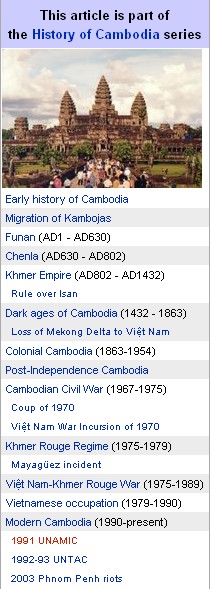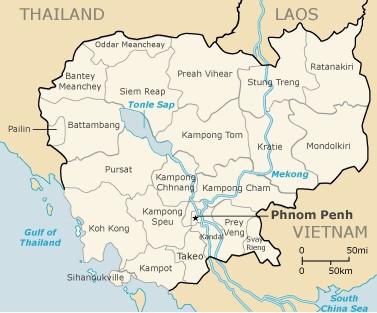this information is quoted from Wikipedia
 Introduction
Introduction
The Kingdom of Cambodia (IPA: [kæmˈbəʊdɪə], formerly known as Kampuchea (IPA: [ˌkæmpuˈtʃiːə], Khmer: ព្រះរាជាណាចក្រកម្ពុជា, transliterated: Preăh Réachéanachâkr Kâmpŭchea) is a country in Southeast Asia with a population of almost 15 million people, with Phnom Penh being the capital city. Cambodia is the successor state of the once-powerful Hindu and Buddhist Khmer Empire, which ruled most of the Indochinese Peninsula between the eleventh and fourteenth centuries.A citizen of Cambodia is usually identified as “Cambodian” or “Khmer,” which strictly refers to ethnic Khmers. Most Cambodians are Theravada Buddhists of Khmer extraction, but the country also has a substantial number of predominantly Muslim Cham, as well as ethnic Chinese, Vietnamese and small animist hill tribes.
The country borders Thailand to its west and northwest, Laos to its northeast, and Vietnam to its east and southeast. In the south it faces the Gulf of Thailand. The geography of Cambodia is dominated by the Mekong river (colloquial Khmer: Tonle Thom or “the great river”) and the Tonlé Sap (”the fresh water lake”), an important source of fish. Much of Cambodia sits near sea level, and consequently the Tonle Sap River reverses its water flow in the wet season, carrying water from the Mekong back into the Tonlé Sap Lake and surrounding flood plain.
Cambodia’s main industries are garments and tourism. In 2006, foreign visitors had surpassed the 1.7 million mark. In 2005, oil and natural gas deposits were found beneath Cambodia’s territorial water, and once commercial extraction begins in 2009 or early 2010, the oil revenues could profoundly affect Cambodia’s economy.
History
Main article: History of Cambodia
The first advanced civilizations in present-day Cambodia appeared in the 1st millennium AD.  During the 3rd, 4th, and 5th centuries, the Indianised states of Funan and Chenla coalesced in what is now present-day Cambodia and southwestern Vietnam. These states, which are assumed by most scholars to have been Khmer,[1] had close relations with China and India.[2] Their collapse was followed by the rise of the Khmer Empire, a civilization which flourished in the area from the 9th century to the 13th century.
During the 3rd, 4th, and 5th centuries, the Indianised states of Funan and Chenla coalesced in what is now present-day Cambodia and southwestern Vietnam. These states, which are assumed by most scholars to have been Khmer,[1] had close relations with China and India.[2] Their collapse was followed by the rise of the Khmer Empire, a civilization which flourished in the area from the 9th century to the 13th century.
The Khmer Empire declined yet remained powerful in the region until the 15th century. The empire’s center of power was Angkor, where a series of capitals was constructed during the empire’s zenith. Angkor Wat, the most famous and best-preserved religious temple at the site, is a reminder of Cambodia’s past as a major regional power.
After a long series of wars with neighbouring kingdoms, Angkor was sacked by the Thai and abandoned in 1432. The court moved the capital to Lovek where the kingdom sought to regain its glory through maritime trade. The attempt was short-lived, however, as continued wars with the Thai and Vietnamese resulted in the loss of more territory and the conquering of Lovek in 1594. During the next three centuries, The Khmer kingdom alternated as a vassal state of the Thai and Vietnamese kings, with short-lived periods of relative independence betweenIn 1863 King Norodom, who had been installed by Thailand,[3] sought the protection of France. In 1867, the Thai king signed a treaty with France, renouncing Suzerainty over Cambodia in exchange for the control of Battambang and Siem Reap provinces which officially became part of Thailand. The provinces were ceded back to Cambodia by a border treaty between France and Thailand in 1906.
Cambodia continued as a protectorate of France from 1863 to 1953, administered as part of the French colony of Indochina. After war-time occupation by the Japanese empire from 1941 to 1945, Cambodia gained independence from France on November 9, 1953. It became a constitutional monarchy under King Norodom Sihanouk.
In 1955, Sihanouk abdicated in favour of his father in order to be elected Prime Minister. Upon his father’s death in 1960, Sihanouk again became head of state, taking the title of Prince. As the Vietnam War progressed, Sihanouk adopted an official policy of neutrality until ousted in 1970 by a military coup led by Prime Minister General Lon Nol and Prince Sisowath Sirik Matak, while on a trip abroad. From Beijing, Sihanouk realigned himself with the communist Khmer Rouge rebels who had been slowly gaining territory in the remote mountain regions and urged his followers to help in overthowing the pro-United States government of Lon Nol, hastening the onset of civil war.[4]
Operation Menu, a series of secret B-52 bombing raids by the United States on suspected Viet Cong bases and supply routes inside Cambodia, was acknowledged after Lon Nol assumed power; U.S. forces briefly invaded Cambodia in a further effort to disrupt the Viet Cong. The bombing continued and, as the Cambodian communists began gaining ground, eventually included strikes on suspected Khmer Rouge sites until halted in 1973. Estimates of the number of Cambodians killed during the bombing campaigns vary widely.[5] As many as 800,000 civilians are believed to have died from the bombings. The Khmer Rouge reached Phnom Penh and took power in 1975, changing the official name of the country to Democratic Kampuchea, led by Pol Pot.Estimates vary as to how many people were killed by the Khmer Rouge regime. Depending on whether or not one includes deaths from starvation and subsequent deaths in refugee camps, estimates range anywhere from 1.7 million[6] to 3 million Cambodians.[7][8] Many were in some way deemed to be “enemies of the state”, whether they were linked to the previous regime, were civil servants, people of education or of religion, critics of the Khmer Rouge or Marxism, or were simply offering resistance to the brutal treatment of the cadres. Hundreds of thousands more fled across the border into neighbouring Thailand.
official name of the country to Democratic Kampuchea, led by Pol Pot.Estimates vary as to how many people were killed by the Khmer Rouge regime. Depending on whether or not one includes deaths from starvation and subsequent deaths in refugee camps, estimates range anywhere from 1.7 million[6] to 3 million Cambodians.[7][8] Many were in some way deemed to be “enemies of the state”, whether they were linked to the previous regime, were civil servants, people of education or of religion, critics of the Khmer Rouge or Marxism, or were simply offering resistance to the brutal treatment of the cadres. Hundreds of thousands more fled across the border into neighbouring Thailand.
In November 1978, Vietnam invaded Cambodia to stop Khmer Rouge incursions across the border and the genocide of Vietnamese in Cambodia.[9] Violent occupation and warfare between the Vietnamese and Khmer Rouge holdouts continued throughout the 1980s. Peace efforts began in Paris in 1989, culminating two years later in October 1991 in a comprehensive peace settlement. The United Nations was given a mandate to enforce a ceasefire, and deal with refugees and disarmament.[10]
After the brutality of the 1970s and the 1980s, and the destruction of the cultural, economic, social and political life of Cambodia, it is only in recent years that reconstruction efforts have begun and some political stability has finally returned to Cambodia. The democracy established following the conflict was shaken in 1997 during a coup d’état,[11] but has otherwise remained in place. Cambodia has been aided by a number of more developed nations like Japan, France, Australia and the United States, primarily economically. Money raised in schools and community groups in these countries has gone towards the rebuilding of infrastructure and housing.
Province,District

Main articles: Provinces of Cambodia and Districts and Sections of Cambodia
Cambodia is divided into 20 provinces (khett, singular and plural) and 4 municipalities (krong, singular and plural). There are further subdivisions into districts (srok), communes (khum), villages (phum), and islands (koh).
Municipalities (Krong):
Provinces (Khett): | Islands (Koh):
|





0 Comments:
Post a Comment